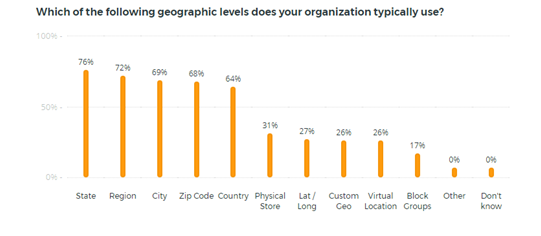Location Intelligence Will Rise In Importance Over Next Three Years As Organizations Realize The Full Potential And Emerging Applications Of The Technology
CARTO, a leader in location intelligence, announced the findings of its “State of Location Intelligence” survey, which polled more than 200 respondents at midsize to large enterprises about their current and future plans to implement location intelligence. The study found that while the knowledge and collection of location data is widespread across organizations, many face challenges to analyzing this data and understanding how mature their location intelligence is.
The goals of the report were to understand –
- How location intelligence is critical to the success of companies, as seen by the business leaders
- The common applications of location intelligence across industries
- The pain points for marketers and data practitioners in adopting location intelligence
- What separates successful businesses from the rest in preparing for a location intelligence-ready organization

Javier de la Torre, CEO and co-founder, CARTO, said, “We’re encouraged by the work we do every day with forward-looking organizations using location intelligence to truly make a change, not only in their business, but in society. It’s evident that more organizations are seeing the value of location data and the benefits possible from incorporating location intelligence insights into business decisions. With the right resources and mindset, we see the potential for smarter business models, more personal experiences, and better access to resources and general improvements to our work and personal lives.”
According to the study, 94 per cent of organizations knowingly collect data with a location component, and 84 per cent of C-level respondents are planning to invest in location intelligence in the next three years. Executives also believe that location intelligence data will grow in importance to their organizations over the next few years, with 68 per cent of respondents saying it is “very” or “extremely” important today and 85 per cent reporting that would be the case in the next three years.
However, the study found that only 17 per cent of analysts say their business performs spatial analysis on their location data, while 39 per cent of C-level executives believe this is the case.
In fact, the most popular software for analyzing location data was Microsoft Excel (54 per cent), indicating many companies don’t support spatial data science methods and techniques.
The survey also found that businesses collecting and analyzing location data will need to overcome some difficult challenges to successfully adopt location intelligence, particularly data quality and accessibility. Nearly half of respondents (49 per cent) said “ensuring data quality and accuracy” is a top challenge.
Analysts were reportedly less aware about the various possible methods to collect this data and related challenges, like extracting data in a useable way, and storing and securing data. However, analysts were more aware of challenges like ensuring data quality and accuracy and gathering data in real time.
Key findings from the State of Location Intelligence 2018
- The top challenges of location intelligence data analysis were extracting, cleaning and transforming the data into a workable format (41 per cent); ensuring sufficient data is available for actionable insights (38 per cent); and making sense of the data (37 per cent).
- Only 27 per cent said they use custom geography and 17 per cent use block groups, indicating most businesses collect location intelligence data with less detail.
- An overwhelming number of respondents that were extremely familiar with location intelligence said artificial intelligence, machine learning and the internet of things were either very important (44 percent) or extremely important (49 percent).
- The availability of location intelligence data across departments varied widely, with 52 percent saying it was either “very accessible” or “extremely accessible,” while 30 percent reported it was “somewhat accessible” and 16 percent said it was “not at all accessible.”






 Image- via CARTO
Image- via CARTO




